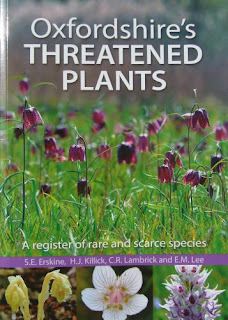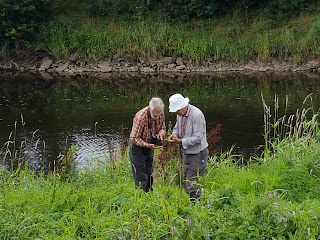 |
Cwm Idwal
Image: F. O'Neill |
Fiona tells us about a fern identification course she attended recently:
"In mid-July I travelled from Cork, with my naturalist
friend, to North Wales to attend a fern (and allies) identification course at the
Field Studies Council
(FSC) centre in Rhyd-y-creuau,
near Betws-y-coed village. We arrived a few days before the course started to
explore a little of North Wales, and really, you should go there, it’s
fantastic, with walks galore and stunning scenery.
"On Friday evening, the course participants
met at Rhyd-y-creuau for dinner followed by an overview of the next three days.
13 attended, with six taking the course for credits towards an MSc, and the
remaining seven having a general interest in ferns. Our tutors were Chris
and Hazel Metherell,
Chris is the current BSBI President and Hazel is an artist and botanist with a
particular interest in ferns.
"On Saturday morning we crammed into the
mini-bus, driven by Chris, and headed to a national nature reserve, Cwm Idwal,
a spectacular glacial corrie in the Glyderau mountain range. There’s a popular
walk around the lake, Llyn Idwal, and other paths branching off it that take
you higher. The day turned misty and drizzly, which didn’t affect the ferns in
the slightest just our views of the cwm and our ability to write on damp
notepaper—the scene below was one I fortunately prepared earlier in the week on
a recce.
 |
Lycopodiella inundata
Image: F. O'Neill |
"The first two ferns Chris stopped at and
used to go through his identification method were the relatively common Dryopteris
dilatata (Broad buckler fern) and Asplenium trichomanes (Maidenhair spleenwort),
the first is tripinnate and the second once-pinnate. Next, we encountered two
upland ferns, Oreopteris limbosperma (Lemon-scented or Mountain fern) and the bushy
Cryptogramma crispa (Parsley fern), the latter is plentiful here, but a rarity
in Ireland.
"As we made our way higher, we paused often to
look closely at ferns, clubmosses, and occasionally other plants found in
alpine habitats, including Saxifraga nivalis (Alpine saxifrage), existing on
just one remaining rock, an indication that alpine plants are really struggling
here.
"Cwm Idwal is home to four clubmosses and we
were fortunate to see all of them: Lycopodium clavatum (Stag’s horn clubmoss), Huperzia
selago (Fir clubmoss), Diphasiastrum alpinum (Alpine clubmoss), and Selaginella
selaginoides (Lesser clubmoss).
 |
Fun times on Saturday night
Image: F. O'Neill |
"Among other unfamiliar ferns I saw were Cystopteris
fragilis (Brittle bladder fern) and Phegopteris connectilis (Beech fern), both
rare in the southern half of Ireland. C. fragilis can resemble young ferns of
other species, therefore care needs to be taken to confirm the ID. P.
connectilis has a couple of unique attributes that are useful in
identification, the pinnae nearest the stem are entirely attached to the stem,
and the lowest pinnae point out and downwards.
"Throughout the day we listened, and took
notes, as Chris and Hazel clearly and patiently imparted their knowledge; Hazel
often went ahead to check out the next species and waited for us to catch up.
"
 |
Asplenium septentrionale
Image: F. O'Neill |
On the way back from Cwm Idwal, we pulled
in to the side of the road and hopped over a stile with Hazel to locate the
fifth clubmoss of the day, Lycopodiella inundata (Marsh clubmoss) by a farm
track.
"That evening, we got a taste of a lively
Saturday night outing for botanists, a trip to a lead mine spoil heap in Gwydyr
Forest Park, looking at Asplenium septentrionale (Forked spleenwort). It likes
to be alone and is into heavy metals.
"On this marathon day we looked at 20 ferns
and five clubmosses.
"On Day 3, we headed to Anglesea, where
we dashed around to seven different sites on a botanical treasure hunt for
ferns and horsetails. Down country lanes for the polypodies, Polystichum
aculeatum (Hard shield fern), and Asplenium adiantum-nigrum (Black spleenwort).
To the coast for some sea air and Asplenium marinum (Sea spleenwort). And
wading through bracken and briars to Thelypteris palustris (Marsh fern) and Dryopteris
carthusiana (Narrow buckler fern).
 |
En route to Dryopteris carthusiana
Image: F. O'Neill |
"In the morning Chris introduced us to
horsetails, and over the day we identified Equisetum arvense (Field horsetail),
the most common species, Equisetum palustre (Marsh horsetail), Equisetum
fluviatile (Water horsetail), and finally Equisetum x meridionale, one clump of
which was near an RSPB reserve and has possibly been there for decades.
"Chris's tip for E. arvense and E. palustre:
remember the acronym ALPS (Arvense: Long, Palustre: Short). This means that when
you compare the length of the first junction of a side branch to the length of
the sheath, it’s E. arvense if it’s longer than the sheath, and E. palustre if
shorter.
"Arriving at our final destination for the day,
we crossed the Menai bridge to nearby Treborth
Botanic Garden, to view two rarities, Polystichum lonchitis (Holly Fern)
and Woodsia alpina (Alpine woodsia).
After dinner at Rhyd-y-creuau, work
continued. We examined polypody spores under the microscope, and Hazel introduced
plant genetics, hybrid vigour, and explained what diploid and triploid plants
are.
 |
Blechnum spicant
Image: F. O'Neill |
"Chris then spoke about the complex Dryopteris affinis group, which is
likely to be split out into many microspecies within the next few years. We
were very happy to just contend with these three:
Dryopteris affinis (Scaly male fern)
Dryopteris borreri (Borrer’s scaly male
fern)
Dryopteris cambrensis (Narrow scaly male
fern).
"On the final morning we travelled to Coed
Felinrhyd, described as “Wales’ own rainforest”. The shady and humid oak
woodland is home to a wealth of ferns and bryophytes, and is a Special Area of
Conservation (SAC) for bats.
"The sheer number of fern species here gave
us the chance to revise what we learned from the previous two days. We were
given the challenge of IDing ferns in the D. affinis group, which, when you’re
with the experts, actually seems possible. We found examples of all three, the
very scaly D. affinis; D. borreri is a neater plant and the pinnules look as if
they’ve been razored across the top; in D. cambrensis the lowest pinnule “steps
up” from the next. Of course, some of these characteristics are variable.
 |
Phegopteris connectilis in Coed Felinrhyd
Image: F. O'Neill |
"A week later ferns, clubmosses, and
horsetails are still on the brain. Chris and Hazel couldn’t have been more
generous with their knowledge and time, we learned so much and felt very lucky
to have them as our tutors.
"Some highlights for me over the weekend included
the abundant clumps of Blechnum spicant (Hard fern) in Coed Felinrhyd, its distinctive
fertile fronds emerging from the centre; a Saturday night out looking at the
heavy metal tolerant A. septentrionale (Forked spleenwort), and finally, seeing
the graceful little P. connectilis (Beech fern) for the first time on Cwm Idwal
and in Coed Felinrhyd.
"Rather than use keys to identify fern
species, Chris and Hazel ask three (sometimes four) questions to arrive at the
answer. The first two questions are always the same, and sometimes are all that
are needed; questions three and four vary, depending on the answer to the
previous two.
Indusium*. Does it have one? What is it
like? For example, is it linear (Asplenium), c-shaped (Dryopteris), or j-shaped
(Athyrium)?
What is the pinnateness of the plant? From
0 to 4, simple to tripinnate.
Examples of question 3 are:
What shape is the frond? For example, does
it taper or stop suddenly?
What are the scales like? For example, do
they have a dark central stripe?
Are the pinnae stalked? Diagnostic for
Asplenium.
The fourth question is only required for a
small number of ferns to reach an ID, an example is:
What colour is the rachis**?
*Indusium: Protective membrane covering the
sporangia.
**Mid-rib, excluding the stipe".
Many thanks to Fiona for telling us about the fern course she attended. I'm looking forward to meeting her on Wednesday, when we'll both be at the BSBI Mayo Recording Event 2018 - any fern I see, I'll be asking Fiona to help me ID it! Watch this space ;-)

























